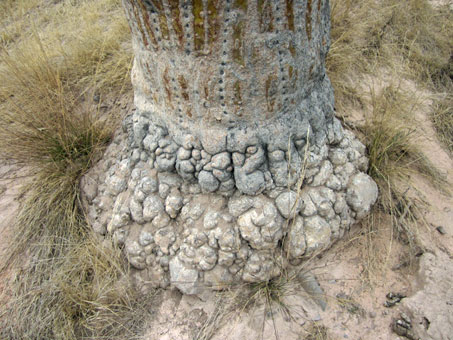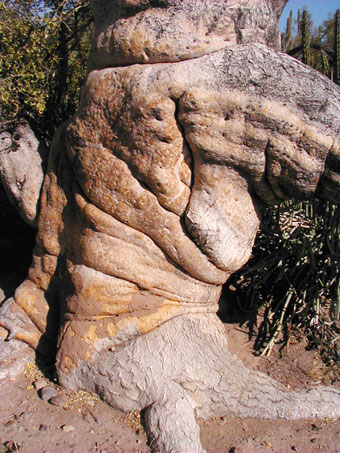APRIL BEE 2014
El Santuario de los Cactos — Mulegé
January 25, 2014
El Santuario de los Cactos, or Cactus Sanctuary, is an absolute botanical gem. It is located about 18 miles south of the capital city of La Paz. Heading south from the city towards El Triunfo and the East Cape, the highway finally leaves behind the city’s sprawling suburbs and heads off into the foothills and the outer edge of the Cape Region’s arid tropical forest. The vegetation along the way is tall and dense, especially by the standards we, who live farther north in Baja California Sur's low, open desert scrublands, are used to.
The turn-off around Km 178 is well-signed. The dirt road leads off at an angle into the forest, twisting and turning for about 3 miles, passing through several dry washes along the way. At about the 15 minute mark, the doubt began to set in as it seemed much farther than I remembered. Was this really the right way? The only sign of life is the fencing on both sides of the road and the fact that the road is superbly maintained. Just around the next corner, I’d say, trying to remember how far we’d gone on our first trip. No, the next…until finally, the local cemetery and the sign for the reserve appeared around a corner.
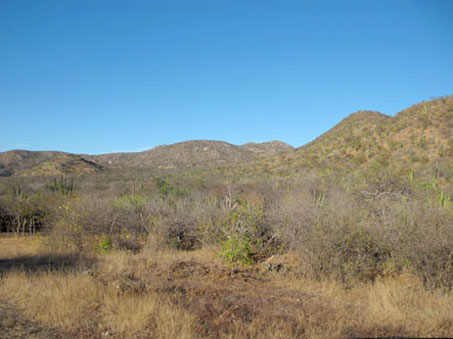
Typical landscape once off the highway. Everything is quite dry, in spite of the good summer/fall rainfall. A wide variety of leguminous shrubs and trees as well as cacti are common.
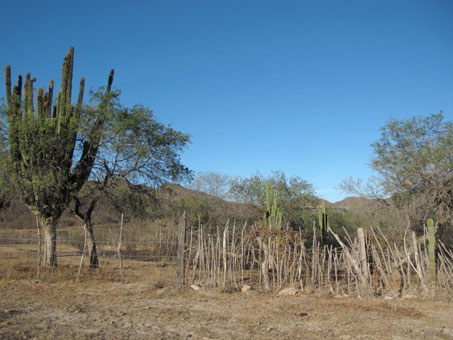
Small corral. The vegetation in the area is relatively open. The tree on the left next to the Cardón Barbón appears to be a Mesquite tree (Prosopis sp.). The fence is made with 4x4´s and cardón ribs.

Dominant plants in the area include: Organ-pipe (foreground) and Cardón Barbon (middle distance) cacti and Lomboi (Ashy limberbush, foreground).
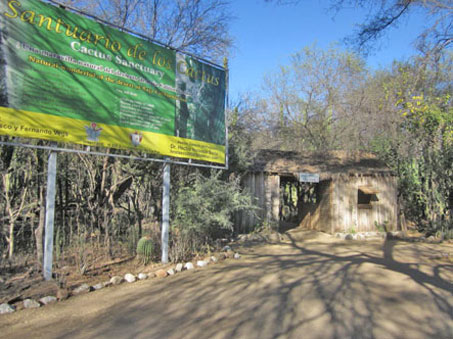
The sanctuary's enormous, government sponsored sign and rustic gate house made from cardón ribs and fan palm fronds. Barren outside, the area inside the fence is dense and mostly ungrazed.
It’s not until after you actually reach the gates of the sanctuary that you realize how much of the surrounding forest has already been lost to grazing. Compared to the city just 18 miles away with its new high density developments, the area is very sparsely populated with people but it’s overrun by livestock. On our first trip there in 2007, we met a herd of cattle ambling along the dirt road and grazing in the forest. Many had multiple cholla (cactus) stems impaled in their faces and sides, signs that not even spiny plants deterred these desert vacuum cleaners. And the trees looked remarkably groomed, the result of cattle and goat pruners.
We were immediately met at the gate by the volunteer (unpaid) caretaker, Demetrio, who was eager to show off the reserve, offering to take us on a free guided tour (he asks for a small donation at the end of the walk, and we were sure to give him a generous tip for his time). He apologized for the cow dung in the gatehouse and paths, explaining that while he had been away, the cows had somehow gotten in and wandered along the paths. The difference between the sanctuary and the outside is like night and day. Walking through the gatehouse, we entered an arid jungle, the trees and arborescent cacti reaching far over our heads and cutting out the bright sunlight. We could see the first of the interpretive signs that are scattered along the trail, and were able to investigate last season's cardón cactus fruits.
The first thing Demetrio pointed out were the epiphytic cacti growing on the gatehouse roof. These were young Cardón Barbón (Pachycereus pectin-aboriginum), Organ-pipe or Pitahaya dulce (Stenocereus thurberi) and Cape Old Man or Garambullo (Lophocereus schottii var. australis) cacti. The three become arborescent in this region of the peninsula.
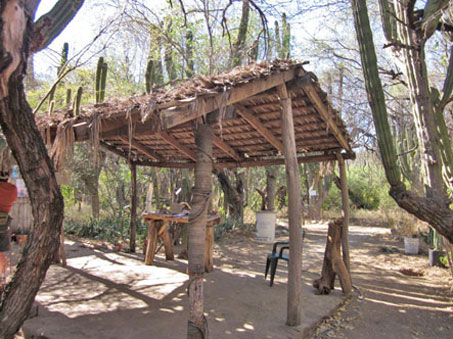
The information center ramada, made from fan palm trunks and fronds. On the roof are young cacti, growing epiphytically.
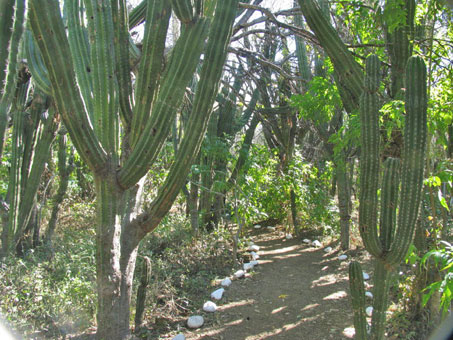
Our first trip to the Sanctuary was in early February 2007, just about four months after Hurricane John. The cacti were immense and still thick with moisture. Arching tree branches add support for the cacti.
 The path from the above photo in 2014. On this year's trip, within days of the date of the last, the experience was quite different due to the dryness.
The path from the above photo in 2014. On this year's trip, within days of the date of the last, the experience was quite different due to the dryness.
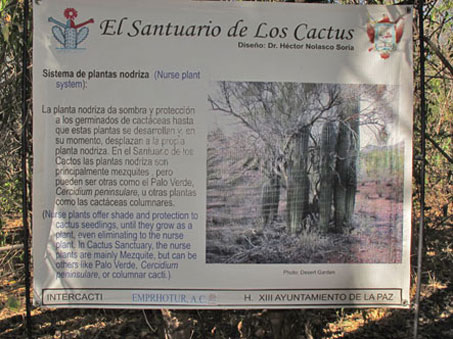
A lot of emphasis is put on the importance of "nurse" trees that grow symbiotically with the arborescent cacti and provide support and shelter for the top-heavy cacti.
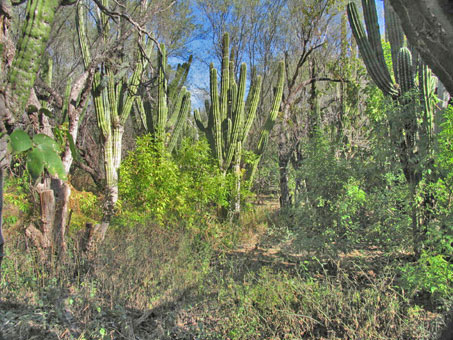
2007. The sanctuary's annual and perennial vegetation was waning, but still incredibly green. Some of the trails were still muddy. The bright green shrub in the middle is Tecoma stans var. stans.
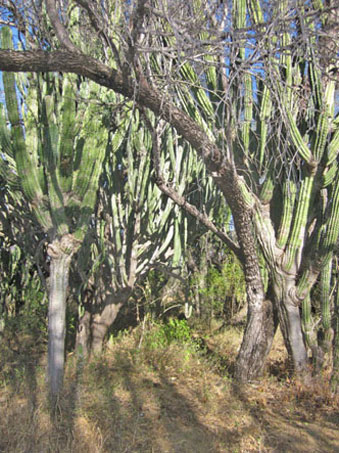 The understory was thinning out and there were only a few species with flowers, the most dominant being Carlowrightia arizonica (see Calphotos image).
The understory was thinning out and there were only a few species with flowers, the most dominant being Carlowrightia arizonica (see Calphotos image).
The sanctuary was inaugurated on International Earth Day in 1997. Collaborators in the project include the international INTERCACTI Group, The Social Development Secretariat (Sedesol) and The Northwestern Biological Research Center (CIB, La Paz). It covers 123 acres, with 14 of these open to the public.
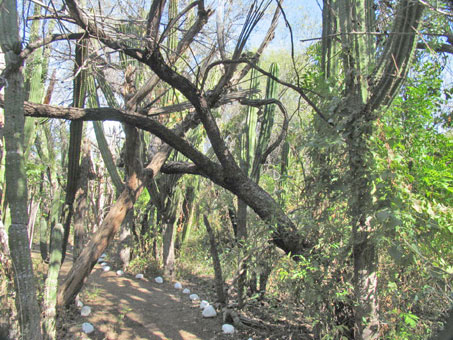
Mesquite "nurse" trees here have intertwined branches or mesh with neighboring trees, providing scaffolding for the cacti as they grow.
 A Garambullo seedling. The cardón behind is growing in the ground.
A Garambullo seedling. The cardón behind is growing in the ground.
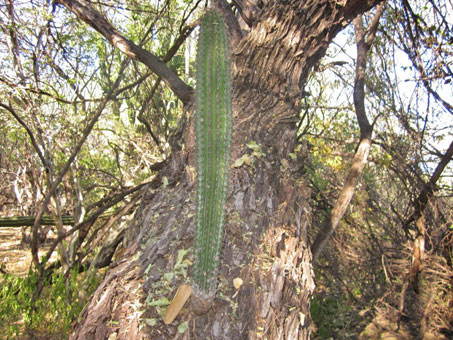
Another function of the "nurse" tree here is to provide new niches for the cacti seedlings, this one a 60 cm Cardón Barbón.
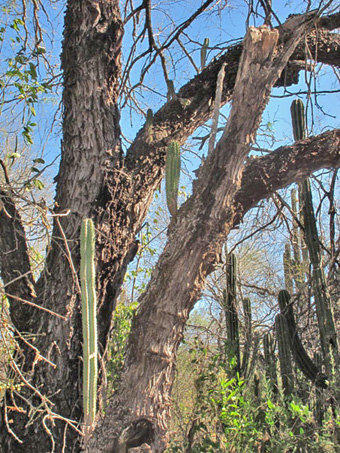 The tall pale cactus is Garambullo (Old-man). The club-shaped one above to the right is a Cardón. How many seedlings can you find?
The tall pale cactus is Garambullo (Old-man). The club-shaped one above to the right is a Cardón. How many seedlings can you find?
On the peninsula, the Cardón Barbón only occurs from the vicinity of La Paz and southward to the cape. It is also found on the mainland. It’s not always easy, especially from afar, to tell it apart from the more common Cardón (P. pringlei) which occurs throughout most of the peninsula. The plant is generally about half the height and size, reaching only 5-8 meters. The trunk is 0.3-0.5 meters in diameter. By comparison, the Cardón reaches more than 20 meters high and the trunk to 1.5 meters in diameter. What I´ve also noticed about the Cardón Barbón is its tendency to have a long trunk that suddenly branches into many side arms which are somewhat short, their tips appearing almost squashed flat. The Cardón has slightly more rounded tips. Unless you get close, you can´t see the differences in the number of ribs (10-12 versus 10-16 in Cardón) or areole and spines.
The arborescent cactus is most easily distinguished when it’s in bud, bloom or fruit. The outer perianth parts of the buds and open flowers are deep red or purple-maroon, whereas the Cardón's are greenish. The fruits are tennis ball-sized and long-bristly, whereas the Cardón’s fruit is a bit smaller and the bristles are very short.
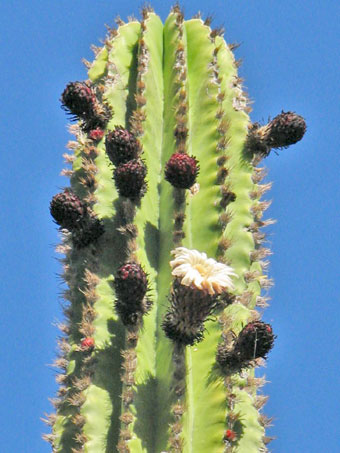 Cardón-Barbón. Note the dark perianth parts, except where they are tan right near the base, and the bristly spines. This occurs only near the tips, where flowers are produced, and forms a pseudo-cephaliumlike structure. Lower on the stems, the spines are gray with black tips, stout and spreading, rather than crowded as above.
Cardón-Barbón. Note the dark perianth parts, except where they are tan right near the base, and the bristly spines. This occurs only near the tips, where flowers are produced, and forms a pseudo-cephaliumlike structure. Lower on the stems, the spines are gray with black tips, stout and spreading, rather than crowded as above.
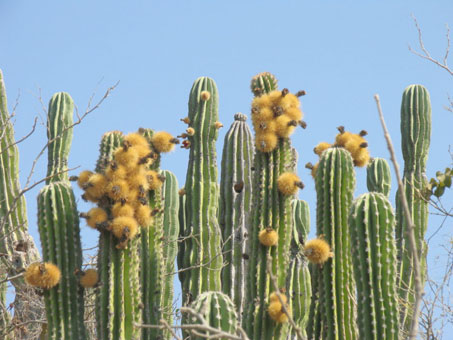
Cardón-Barbón. The fruit in the two photos may look similar, but note the dark perianth parts still left at the tips of the fruit which look very fuzzy because of 2-6 cm long bristles. The fruit is 6-7.5 cm D. Compare the rib spines with the photo on right. June 2005.
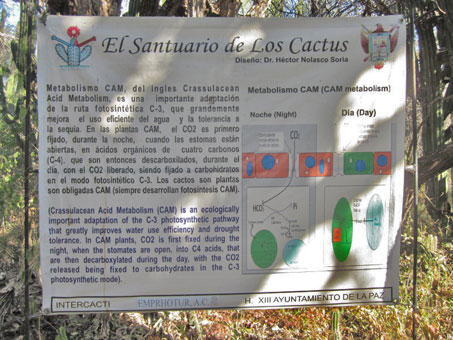
The reserve has informative, bilingual signage, like this one describing the Crassulacean Acid Metabolism. Click image to enlarge.
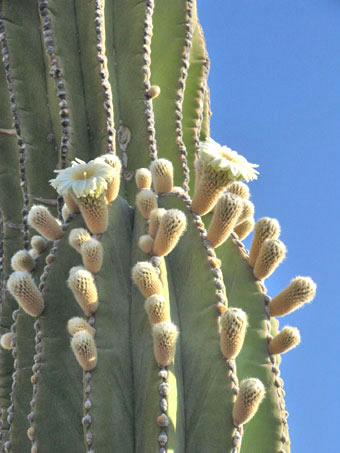 Cardón. Note that the outer perianth parts are covered uniformly in tan bristles. Only the uppermost parts are green. Also note the naked nubs along the ridges of the ribs. These are the areoles that used to have thin, gray, spreading spines. With age, the Cardón tends to lose its spines all along the length of its ribs.
Cardón. Note that the outer perianth parts are covered uniformly in tan bristles. Only the uppermost parts are green. Also note the naked nubs along the ridges of the ribs. These are the areoles that used to have thin, gray, spreading spines. With age, the Cardón tends to lose its spines all along the length of its ribs.
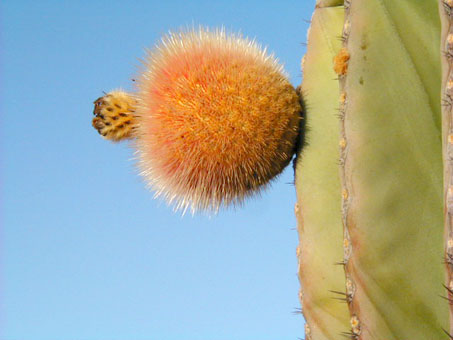
Cardón. Note the pale color of the leftover perianth and the fruit´s short bristles which are gen. less than 1 cm L. The fruit looks a bit like a tennis ball on the outside, and is 5-7 cm D. Notice the sparse spines along the ribs in the flowering region of the plant. June 2005.
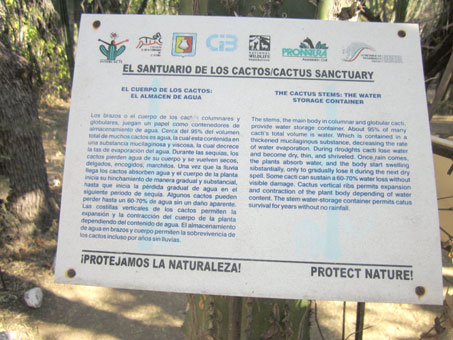
Sign describing how the Cactus Family (Cactaceae) stores moisture. Click image to enlarge.
As I´ve mentioned, the Cardón Barbón is just one of three arborescent cacti in the reserve. There is also the Organ Pipe or Pitahaya Dulce (Stenocereus thurberi) and the Garambullo or Cape Old-man Cactus (Lophocereus schottii var. australis). In drier parts of the peninsula, such as Mulegé, both the common, widespread variety of Garambullo (Lophocereus schottii var. schottii) and Pitahaya dulce lack a trunk and the often tightly clustered stems emerge at ground level. Both may reach 6 m high, but 3 meters and 4-5 meters respectively is more common in my area.
By comparison, the Cape Region´s variety of Garambullo usually has a short trunk and may reach 8 meters high. The Pitahaya dulce also may develop a short trunk in the region and easily top off at 8 meters.
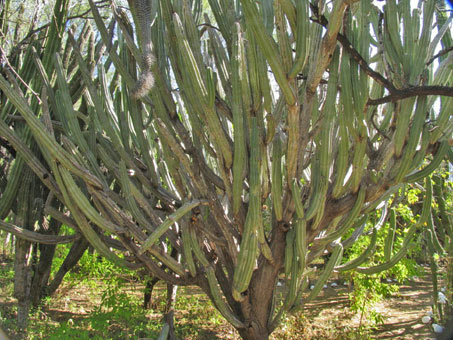
This imposing Garambullo, photographed in 2007, was at least 7.5 m high and 4.5 m wide. I remember standing under it looking up, my mouth agape. I had never seen such a large Garambullo. It was so tall, that the tops of many of the stems had sagged under their weight and were dipping downwards.
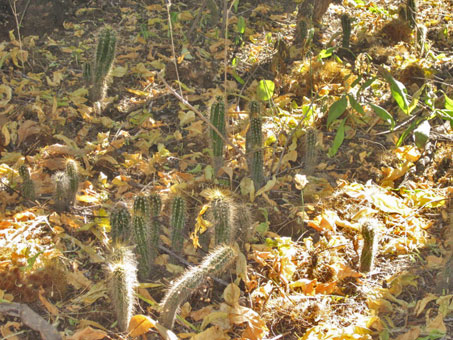
From seedling, to...

Looking like a bunch of leggy, leafless twigs, this is actually a primitive cactus species, Pereskiopsis porteri. It is shrubby and can become vinelike, using other plants for shade and support. It is known locally as Rajamatraca or Alcajér (see photo below).
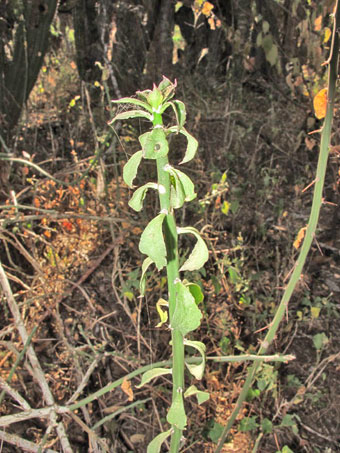 There were still a few of the Rajamatraca with leaves. It has glochids and 1-3 long, thin spines (seen on branch on far right). The flower is yellow.
There were still a few of the Rajamatraca with leaves. It has glochids and 1-3 long, thin spines (seen on branch on far right). The flower is yellow.

Sadly, the amazing cactus didn´t survive Hurricane Jimena in 2009. Demetrio said that initially, it looked like it had survived and was still standing after the storm, but not long afterwards, it suddenly toppled with an enormous crash. Four and a half years later, most of its stems are nicely decomposing.
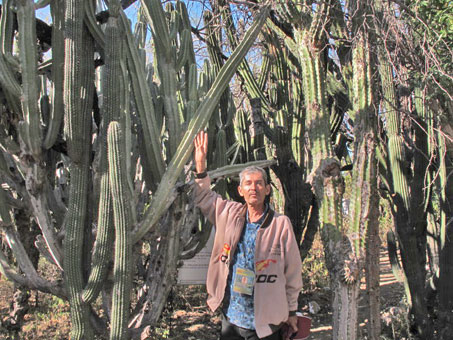
...trees. The reserve protects the seedlings from grazing.

A fruiting specimen of a southern BCS endemic barrel cactus or Biznaga (Ferocactus townsendianus var. townsendianus). Flowers are orange, tinged with red and superficially similar to those of Ferocactus peninsulae.
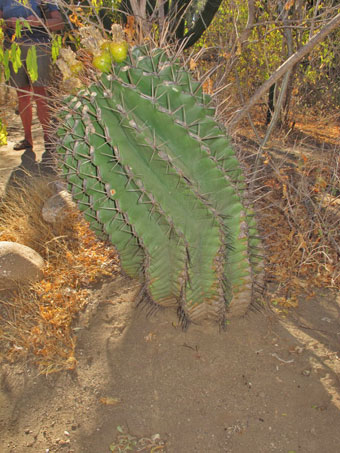 Biznaga stands about 0.5 m H. The 3-4 central spines are stout, and the principal one is strongly hooked at the tip. Barrel cacti are at risk because ranchers feed them to livestock in times of drought.
Biznaga stands about 0.5 m H. The 3-4 central spines are stout, and the principal one is strongly hooked at the tip. Barrel cacti are at risk because ranchers feed them to livestock in times of drought.
Some of the Pitahaya dulce have interrupted stem growth, with many small segments, such as in the photo below, left. A botanist told me once that when there is damage to the central meristem, cacti will compensate by sprouting a new stem from lateral areoles, which is where branches and flowers arise, and then this continues upward stem growth. Damage could occur from a number of sources, such as mechanical, fungal, herbivory or genetic mutation.
The Pitahaya dulce in the photo below, right, has both this form of growth and a genetic mutation called fasciation. Stems with this mutation are referred to as fasciated, crested or cristate. A good description of this phenomenon can be found in this PDF (172 kb) from the San Gabriel Valley Cactus and Succulent Society. Another web page with photos of hundreds of fascinating examples and a explanation of the anomaly can be found here.
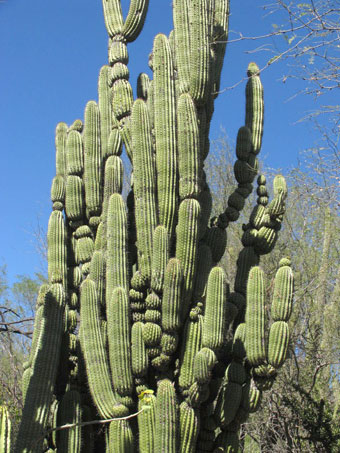
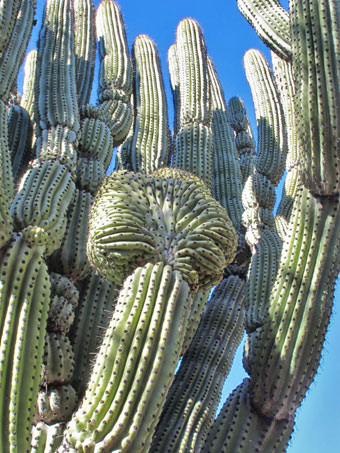
While we all enjoyed the cactus in the reserve, I was also very interested in identifying the other herbs, shrubs and trees. Unfortunately, Demetrio was not as familiar with them as he was with the cacti, and the signs didn´t mention them all. There were a number of familiar plants, such as Carlowrightia arizonica (see CalPhoto image) that I mentioned earlier, as well as Jatropha cinerea (Ashy Limberbush, Euphorbiaceae) and Palo de Arco (Tecoma stans var. stans, Bignoniaceae). This last plant can be seen at UCBG, planted in the New World Desert section. It sits right next to the bench on the south side of the main road just before the Asia section. When I first saw the specimen at UCBG, the first thing I noted was how small the leaves and flowers were compared to those in their natural habitat.
This species is from the Americas, native in Mexico and many parts of Central and South America. On the Peninsula, it is probably one of the most common ornamental species. While it grows well in Mulegé in gardens, and commonly escapes when there is a water source available, it doesn´t occur in the wild. It ranges in the southern half of BCS, from around Loreto and southward to the Cape.
At the Sanctuary, as we walked along the trail, I realized at some point that it was one of the principal shrubs inside the fenced area. Demetrio explained to our group that because the branches are so flexible, yet strong, the indigenous people used them to make bows (hence its common name, Palo de arco = bow stick). He then proceeded to take a half-inch branch and bend it in almost a complete circle!
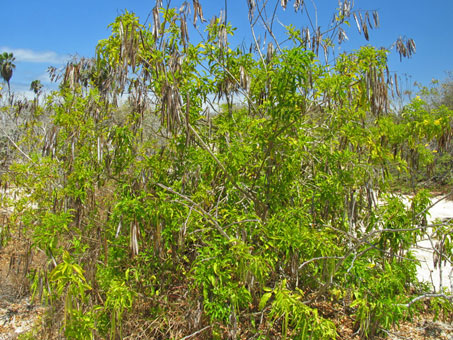
Palo de Arco habit (Tecoma stans var. stans, Bignoniaceae).
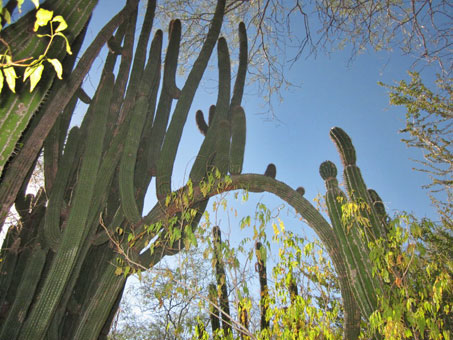
Pitahaya dulce arcing over the path and framing a Palo de Arco bush invites visitors to enter the enchanted forest.

Attractive to native hummingbirds and bees, Palo de Arco flowers are about 4 cm L and 2 cm D.
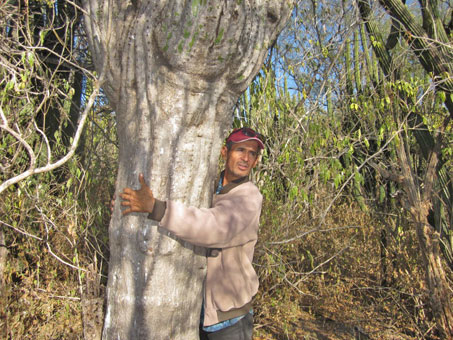
Demetrio´s love for the sanctuary and his cactus wards is clearly evident during his guided tour. One of the bigger Cardón Barbóns.
We have come to the end of the virtual tour of the Santuario de los Cactos. I hope you enjoyed this glimpse at another of Baja California´s little known treasures. It is well worth the visit, if only to experience the majesty and mass of these giant cacti and their tree guardians in their unique arid tropical forest. I´m planning to visit again after a good rainy season but earlier in the Fall, and hope that one day you´ll get the chance to check it out too.
Mulegé — Apr. 15
Following up on one of the topics from the previous post this month, I thought I'd add some more photos of a crested cacti that I found just a few days ago. I've come across only a couple in the Mulegé area over the years, so I was pleasantly surprised to find a crested Pitahaya Agria (Galloping Cactus, Stenocereus gummosus) a mere 75 meters from our place. There´s a vacant lot and a couple of months ago there were surveyors laying out the property lines. In order to do so, they had to hack away some vegetation. And they inadvertently made access to the crested cactus possible. The cactus had about ten stems or branches, at least four of them with crests and multiple crests. Their forms were interesting...
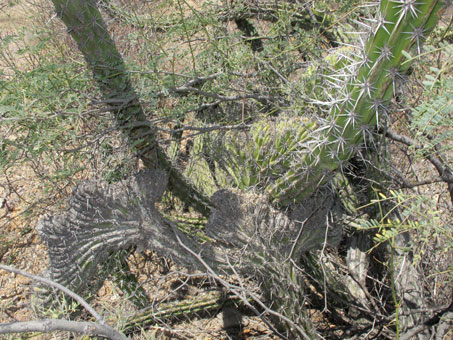
One of the branches with multiple crested parts.
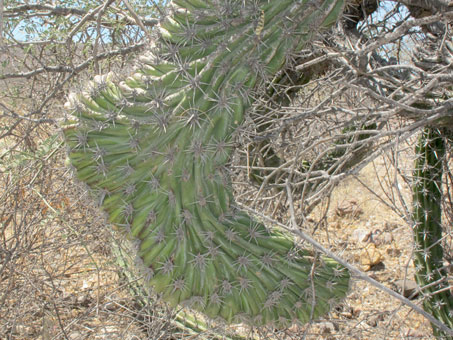
The Boot.
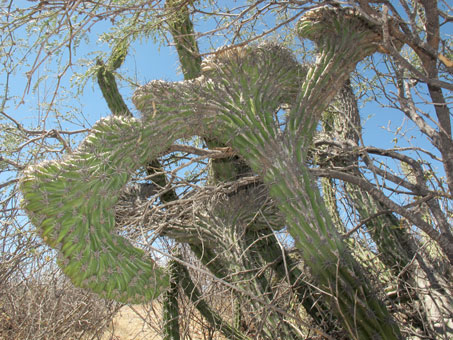
A lower angle shows another multi-crested branch behind.
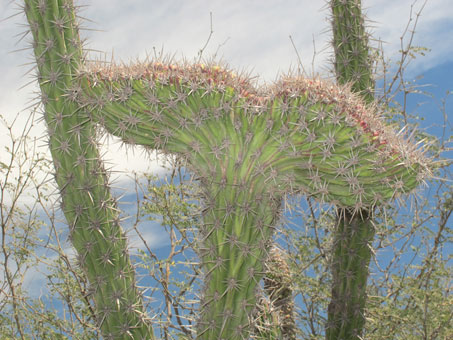
The Whale's Tail. On the right, low and behind is a bit of the Club.
And for a couple more photos of strange cacti. Here are two of Cardón (Pachycereus pringlei). The etymology of the genus name is from the Greek word pachys, meaning thick and the Latin word cereus, meaning candle. The first photo explains why this species is commonly called Elephant Cactus. The second image kind of looks like a candle that is melting in the heat!
Until next month, hasta pronto...
Debra Valov—Curatorial volunteer








































